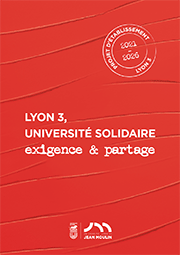AccueilRechercheProgrammes et productions scientifiquesThèsesThèses soutenuesThèses soutenues - 2006-2021Thèses soutenues - 2016
-
Partager cette page
- Recherche,
RACAT Margot
L’influence de la stimulation tactile lors de l’évaluation en ligne du produit
Publié le 19 décembre 2016 – Mis à jour le 31 octobre 2017
Thèse en Sciences de Gestion soutenue le 21 novembre 2016.
Ce travail de recherche doctorale étudie l’influence de la stimulation tactile de l’interface lors de l’évaluation en ligne du produit. A travers un plan d’expériences composé d’une étude exploratoire au design de recherche mixte et de trois expérimentations, nous cherchons à identifier, dans un premier temps, l’effet de l’absence d’interaction directe avec le produit (étude exploratoire) puis nous testons l’effet du type de test de produits sur la préférence d’achat du consommateur (i.e. physique vs. virtuel) (étude 1). Dans un deuxième temps, nous étudions l’effet de la stimulation tactile directe de l’interface sur la perception de similarité du test et l’influence de cette dernière sur l’évaluation du produit. En particulier, nous testons deux effets: celui de la congruence entre la stimulation tactile de l’interface et la texture du produit (étude 2) puis celui de la familiarité des textures (étude 3). D’une part, nous montrons que le consommateur est à la recherche d’interaction sensorielle lors de son interaction virtuelle avec les produits, ce qui lui permet de considérer cette expérience virtuelle comme plus réaliste, notamment au niveau sensoriel (étude exploratoire). Nous montrons également que le consommateur préfère l’expérience virtuelle du produit malgré le manque significatif d’interactions sensorielles, notamment tactiles (étude 1). D’autre part, nous montrons que l’interaction des textures entre l’interface et le produit influence négativement la similarité per?ue du test (étude 2) tandis que, lorsque les textures ne sont pas familières, l’interaction des textures influence positivement la similarité per?ue (étude 3). A partir de ces résultats, nous concluons que le consommateur est à la recherche de stimulation tactile lors de son expérience virtuelle avec le produit afin de satisfaire son besoin de toucher et d’enrichir son expérience sensorielle en ligne. En particulier, l’effet positif de l’interaction des textures, lorsque la stimulation n’est pas familière, sur la similarité per?ue du test suggère que les consommateurs considèrent l’information tactile comme suffisante pour percevoir une similarité sensorielle à celle obtenue en magasin.
Our doctoral research examines the influence of tactile stimulation in online product evaluation. With an exploratory study and three experiments, we aim at identifying the effect of the absence of direct product touch (exploratory study), and then concentrate on the effect of the type of product testing on the consumer’s preference for purchasing (physical vs. virtual) (study 1). Next, we look at the influence of the interface tactile stimulation on the perceived product test similarity, of which the latter positively influences the online product evaluation. In particular, we test two types of effect: the congruence (study 2) and the familiarity of the textures (study 3). On the one hand, our results show that consumers are seeking a higher sensory input into online environments while interacting with products, especially from a tactile perspective (exploratory study). Results also highlight that consumers prefer the online product experience, even though they regret the absence of products' tactile sensations (study 1). On the other hand, we demonstrate that the interaction between the interface's direct tactile stimulation and the product's texture negatively influence the perceived similarity of product testing when textures fit, whereas when the textures are unfamiliar, the interaction of texture positively influences the perceived similarity of product testing. From these results, we conclude that consumers are in need of tactile input into virtual product experiences to satisfy their need for touch, and enhance their online sensory experiences. Notably, the positive effect of the interaction of textures, in an unfamiliar tactile stimulation, suggests that consumers consider the direct tactile stimulation as not being sufficient enough to provide useful information, but they assimilate it to a real product testing from a tactile perspective.
Our doctoral research examines the influence of tactile stimulation in online product evaluation. With an exploratory study and three experiments, we aim at identifying the effect of the absence of direct product touch (exploratory study), and then concentrate on the effect of the type of product testing on the consumer’s preference for purchasing (physical vs. virtual) (study 1). Next, we look at the influence of the interface tactile stimulation on the perceived product test similarity, of which the latter positively influences the online product evaluation. In particular, we test two types of effect: the congruence (study 2) and the familiarity of the textures (study 3). On the one hand, our results show that consumers are seeking a higher sensory input into online environments while interacting with products, especially from a tactile perspective (exploratory study). Results also highlight that consumers prefer the online product experience, even though they regret the absence of products' tactile sensations (study 1). On the other hand, we demonstrate that the interaction between the interface's direct tactile stimulation and the product's texture negatively influence the perceived similarity of product testing when textures fit, whereas when the textures are unfamiliar, the interaction of texture positively influences the perceived similarity of product testing. From these results, we conclude that consumers are in need of tactile input into virtual product experiences to satisfy their need for touch, and enhance their online sensory experiences. Notably, the positive effect of the interaction of textures, in an unfamiliar tactile stimulation, suggests that consumers consider the direct tactile stimulation as not being sufficient enough to provide useful information, but they assimilate it to a real product testing from a tactile perspective.
Mots-Clés : toucher, environnement virtuels, congruence, interactions Homme-Machine.
Keywords : touch, virtuals environnements, congruence, Human-Machine interactions
Directrice de thèse : Sonia CAPELLI
Membres du jury :
- MAILLE Virginie Professeure HDR SKEMA Business School Nice Rapporteure
- PONCIN Indrid Professeure Université Catholique de Louvain, Belgique Rapporteure
- CAPELLI Sonia Professeure des universités Université Jean Moulin Lyon 3 Directrice de thèse
- VANHEEMS Régine Professeure des universités Université Jean Moulin Lyon 3 Examinatrice
- BREE Jo?l Professeur des universités ESSCA Angers Président
Président du jury : Jo?l BREE
Equipe d'accueil : MAGELLAN
Décision : AdmisKeywords : touch, virtuals environnements, congruence, Human-Machine interactions
Directrice de thèse : Sonia CAPELLI
Membres du jury :
- MAILLE Virginie Professeure HDR SKEMA Business School Nice Rapporteure
- PONCIN Indrid Professeure Université Catholique de Louvain, Belgique Rapporteure
- CAPELLI Sonia Professeure des universités Université Jean Moulin Lyon 3 Directrice de thèse
- VANHEEMS Régine Professeure des universités Université Jean Moulin Lyon 3 Examinatrice
- BREE Jo?l Professeur des universités ESSCA Angers Président
Président du jury : Jo?l BREE
Equipe d'accueil : MAGELLAN
Documentation
Mise à jour : 31 octobre 2017







